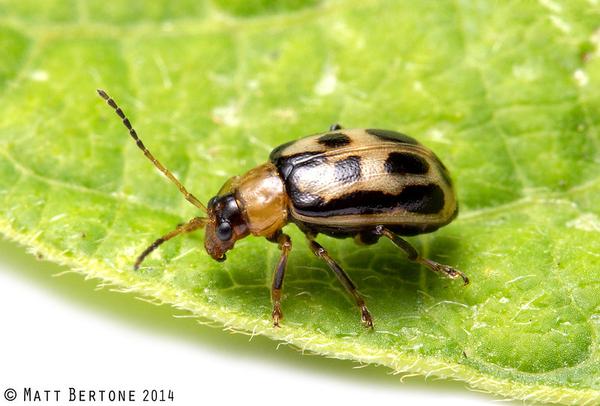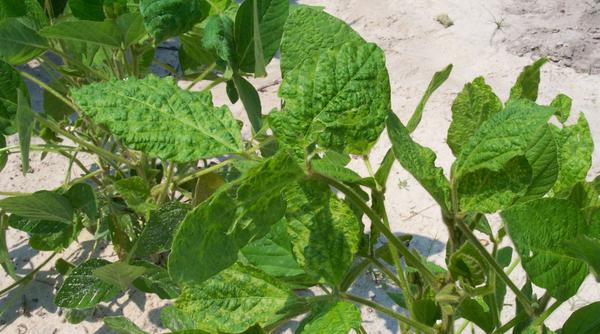Bean Pod Mottle Virus
- Type
- Disease
- Leaf Condition
- Distorted, Stunted, Brittle, Leaf Spot
- Leaf Location
- Upper, Lower, Young, Mature
- Plant Size
- Stunted
- Field Distribution
- Random, Localized Area
- Prior Environmental
- Cool Cloudy
- Season
- Early Vegetative, Mid To Late Vegetative, Flowering, Pods Present, Post Harvest
- Cropping System
- Soybean Followed By Soybean, Conventional Till, Reduced Till
Introduction
Bean pod mottle is caused by bean pod mottle virus (BPMV). The disease was first reported affecting soybean (Glycine max L.) in 1951 in Arkansas, but has spread to all soybean production regions in the United States. BPMV can cause yield losses as high as 52% and reduce seed quality. Higher yield losses can be observed if plants are infected on or before the V6 stage or co-infections with Soybean mosaic virus. In North Carolina, Bean pod mottle virus was first observed in 1958, but does not cause significant annual losses.
Pathogen
BPMV is a member of the genus Comovirus in the family Comoviridae. Morphologically the virus is comprised by a bipartite, positive, single-stranded RNA. Two RNA molecules are independently encapsidated in isometric particles of 28 nm in diameter.
BPMV is transmitted by leaf-feeding beetles (Figure 1), specifically the bean leaf beetle (Cerotoma trifurcata). Virus may also be introduced via sap or infected seed, but seed transmission rates are very low (< 0.1%). Virus is acquired by bean leaf beetles feeding on infected plants and transmitted to susceptible host plants as they move through a field to feed on plants.
Host Range
BPMV has been reported affecting many economically important legumes including, common beans (Phaseolus vulgaris L.) and lima beans (Phaseolus lunatus L.) and Lespedeza sp., Stizolobium deeringianum Bort., and Trifolium incarnatum L.
Life Cycle and Favorable Conditions for Disease
Bean leaf beetles overwinter in leaf litter in wooden areas. Seed transmission has been reported, but it is unlikely to contribute to the disease epidemic significantly. Following overwintering, bean leaf beetles emerge in mid to late April and move to early legumes such as Desmodium sp. and alfalfa (Medicago sativa). Beetles acquire the virus from weed hosts that are affected. The beetles colonize soybeans as soon as seedlings emerge. There is no latent period from when the beetle acquires and is able to transmit the virus. The beetle is also able to transmit the virus for several days after feeding from an infected plant. Conducive environmental conditions include warm winters, since bean leaf beetle mortality increases under freezing conditions.
Symptoms
Symptom development is favored by cool temperatures, but may not be apparent in higher temperatures or after pod set. Symptoms first appear on the younger leaves and can range from mild chlorotic mottling of foliage to a severe mosaic (Figure 2). Green stem may also occur. In severe infections, stunting, leaf distortion and puckering and reduced pod size are also common. Since BPMV is caused by a virus, there are no physical signs of the pathgogen and the presence of the disease in the field needs to be confirmed through lab testing.
Management
Currently, there are no BPMV resistant soybean varieties commercially available. The value of managing this virus with insecticides is not well understood in this region. Managing weed hosts within fields may also reduce reservoirs for virus.
Useful Resources
The Crop Protection Network Fact Sheet provides more information on BPMV.
The NC State University Plant Disease and Insect Clinic provides diagnostics and control recommendations.
The NC State Extension Plant Pathology portal provides information on crop disease management.
The North Carolina Agricultural Chemicals Manual provides pesticide information for common diseases of North Carolina. The manual recommendations do not replace those described on the pesticide label, and the label must be followed.
Acknowledgements
This factsheet was originally prepared by the NC State University Field Crops and Tobacco Pathology Lab in 2020.
- Check out our Facebook and our Twitter!




